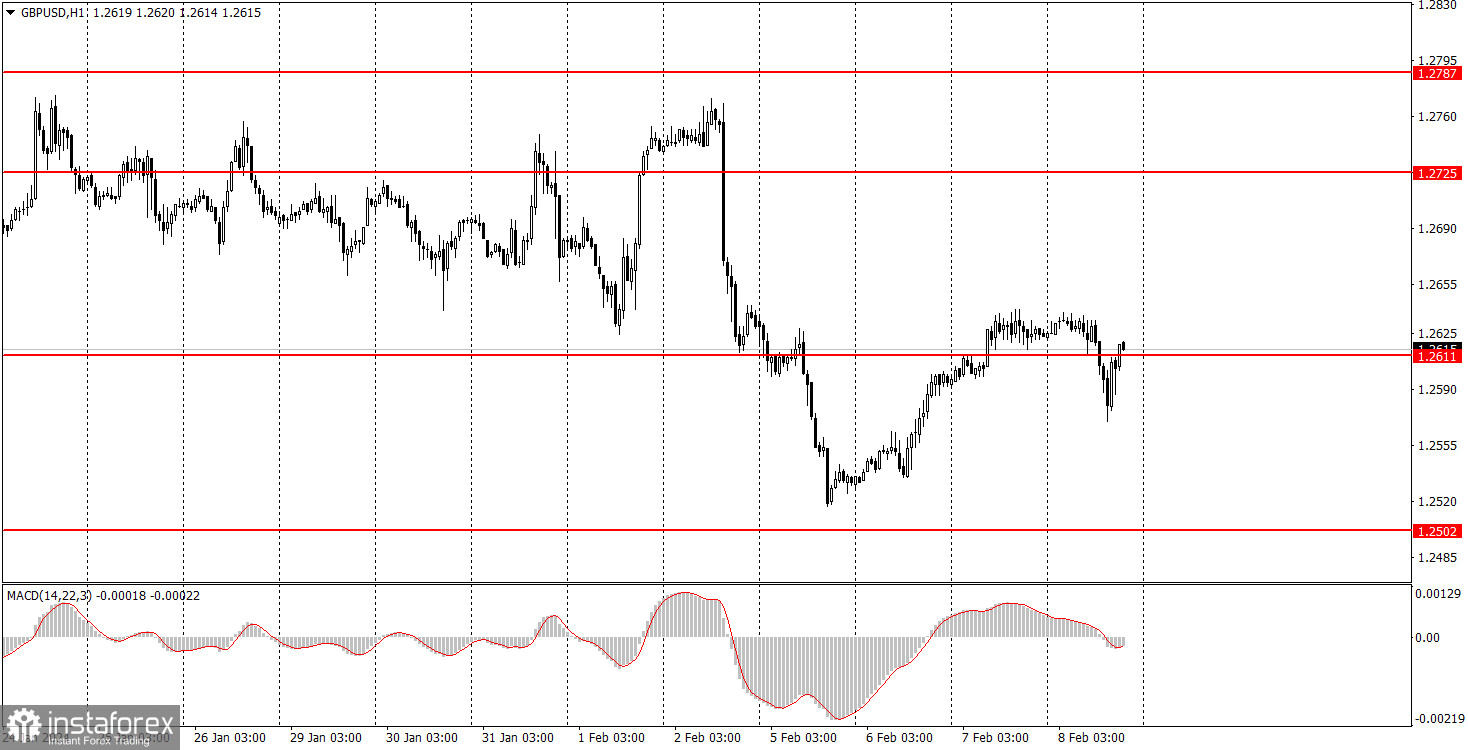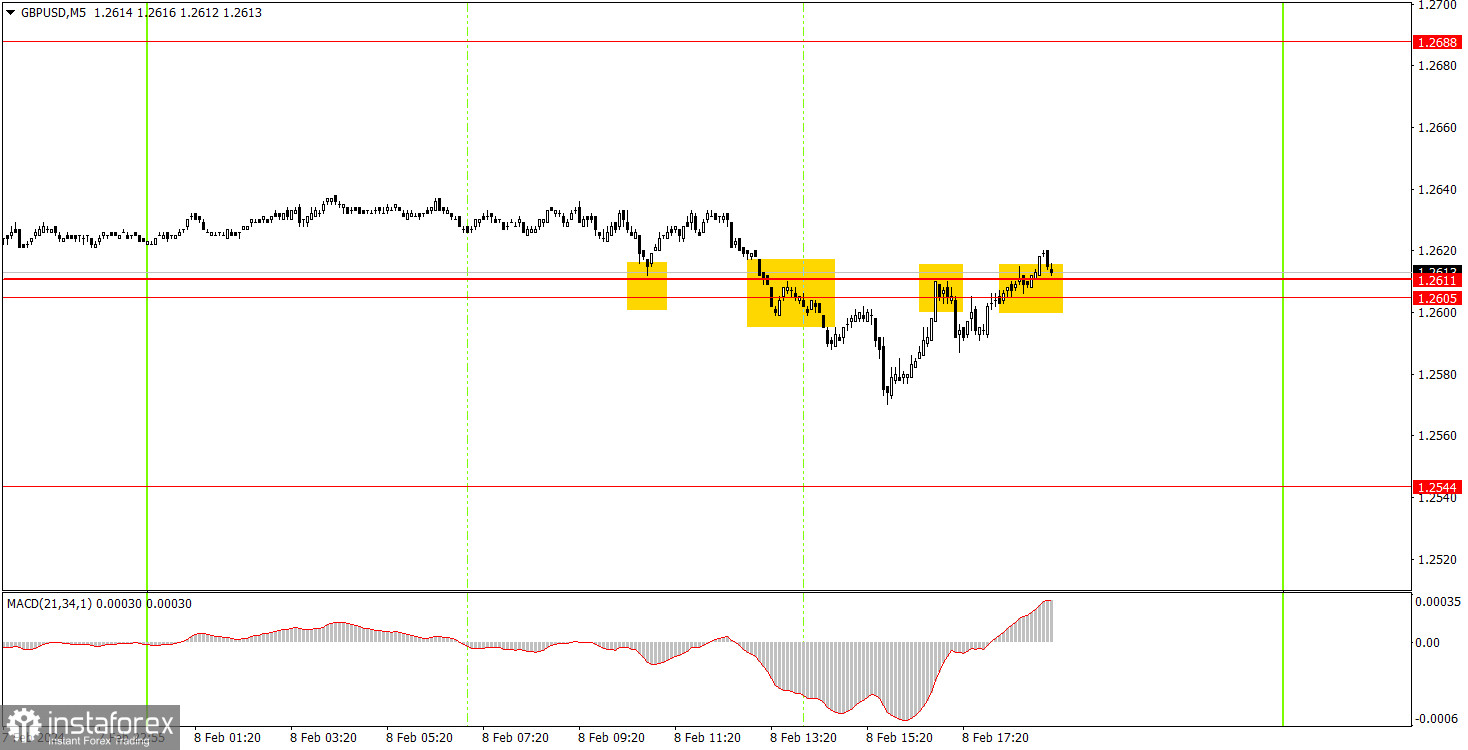Analyzing Thursday's trades:
GBP/USD on 1H chart

GBP/USD tried to start a new downward trend on Thursday, which began last week, but the price quickly moved back up. The main downside is the market's complete disregard for the level of 1.2611, which has long served as the lower boundary of the sideways channel. It seems that this level means absolutely nothing now and offers no resistance to traders. The British currency fell by 50% due to the US jobless claims report. This report cannot be considered significant, but in the absence of other market-moving events, traders reacted to even this mundane, secondary report. As a result, we observed quite chaotic movements. The pair corrected higher after the initial fall, which was expected, but now it is difficult to resume the main trend.
GBP/USD on 5M chart

The movements on the 5-minute timeframe were weak once again. The pair covered a range of 66 pips from the day's low to the high, which is low for the British pound. All of the trading signals formed around the 1.2605-1.2611 area, and all of them were false signals, since it was a weak movement. Traders could have executed the first two signals. The first one (a buy signal) resulted in a small loss, and the second one closed at the Stop Loss with no profit or loss. Therefore, traders ended the day in the negative, but there is nothing to worry about, as it is impossible to make a profit every day. The main thing is to try to minimize losses.
Trading tips on Friday:
On the hourly chart, GBP/USD has left the sideways channel of 1.2611-1.2787 but has already returned to it. The previous week's as well as Monday's fundamental and macroeconomic background only supported the dollar, so it was only logical for us to see a downtrend. However, the downtrend must continue. But it has been extremely difficult to expect strong movements from the market this week, and traders are just ignoring the crucial level of 1.2611. Most likely, the confusion will prsist on Friday.
The key levels on the 5M chart are 1.2270, 1.2310, 1.2372-1.2387, 1.2457, 1.2502, 1.2544, 1.2605-1.2611, 1.2688, 1.2725, 1.2787-1.2791, 1.2848-1.2860, 1.2913, 1.2981-1.2993. On Friday, there are no important events or reports lined up in the UK and the US. Thus, there will be nothing to react to, and volatility will likely remain low.
Basic trading rules:
1) Signal strength is determined by the time taken for its formation (either a bounce or level breach). A shorter formation time indicates a stronger signal.
2) If two or more trades around a certain level are initiated based on false signals, subsequent signals from that level should be disregarded.
3) In a flat market, any currency pair can produce multiple false signals or none at all. In any case, the flat trend is not the best condition for trading.
4) Trading activities are confined between the onset of the European session and mid-way through the U.S. session, after which all open trades should be manually closed.
5) On the 30-minute timeframe, trades based on MACD signals are only advisable amidst substantial volatility and an established trend, confirmed either by a trendline or trend channel.
6) If two levels lie closely together (ranging from 5 to 15 pips apart), they should be considered as a support or resistance zone.
How to read charts:
Support and Resistance price levels can serve as targets when buying or selling. You can place Take Profit levels near them.
Red lines represent channels or trend lines, depicting the current market trend and indicating the preferable trading direction.
The MACD(14,22,3) indicator, encompassing both the histogram and signal line, acts as an auxiliary tool and can also be used as a signal source.
Significant speeches and reports (always noted in the news calendar) can profoundly influence the price dynamics. Hence, trading during their release calls for heightened caution. It may be reasonable to exit the market to prevent abrupt price reversals against the prevailing trend.
Beginners should always remember that not every trade will yield profit. Establishing a clear strategy coupled with sound money management is the cornerstone of sustained trading success.
 English
English 
 Русский
Русский Bahasa Indonesia
Bahasa Indonesia Bahasa Malay
Bahasa Malay ไทย
ไทย Español
Español Deutsch
Deutsch Български
Български Français
Français Tiếng Việt
Tiếng Việt 中文
中文 বাংলা
বাংলা हिन्दी
हिन्दी Čeština
Čeština Українська
Українська Română
Română

